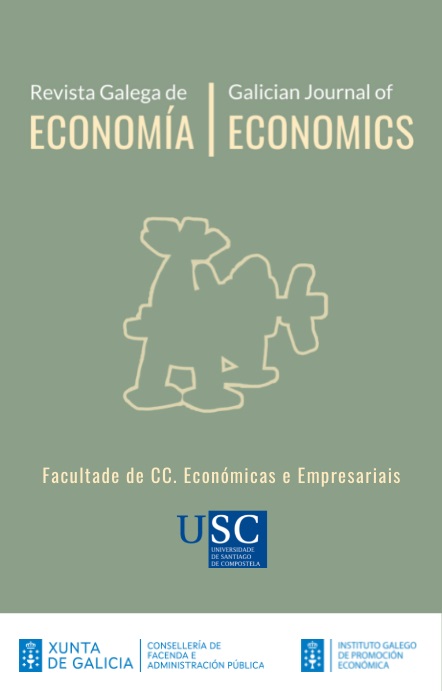El extraño caso del ataque a la eurozona: ¿de quién es la culpa?
Contenido principal del artículo
Resumen
Palabras clave:
Detalles del artículo
Referencias
ALVES, R.H. (2009): A Europa no pós-euro: desafios e respostas. Porto: Vida Económica.
ALVES, R.H.; AFONSO, O. (2007): “The New Stability and growth Pact: More Flexible, Less Stupid?”, Intereconomics, 42 (4), pp. 218-225.
ALVES, R.H.; AFONSO, O. (2008): “Fiscal Federalism in the European Union: How Far Are We?”, en J. Ferreiro, G. Fontana e F. Serrano [ed.]: Fiscal Policy in the EU, pp. 6-24. Palgrave Macmillan.
ARESTIS, P.; MCKAULEY, K.; SAWYER, M. (2001): “An Alternative Stability Pact for the European Union”, Cambridge Journal of Economics, 25 (1), pp. 113-130.
BALDWIN, R.; WYPLOSZ, C. (2009): The Economics of the European Union. McGraw Hill.
BARBOSA, J.R.; ALVES, R.H. (2011): “The Euro Area Ten Years After Its Creation: (Divergent) Competitiveness and the Optimum Currency Area Theory”, Panoeconomicus, 58 (5), (Special Issue), pp. 605-629.
BUITER, W.; CORSETTI, G.; ROUBINI, N. (1993): “Excessive Deficits: Sense and Nonsense in the Treaty of Maastricht”, Economic Policy: A European Forum, 16, pp. 58-100.
BUKOWSKI, S. (2006): The Maastricht Convergence Criteria and Economic Growth in the EMU. (Quaderni del Dipartimento di Economia, Finanza e Statistica, 24/2006). Perugia: Università di Perugia, Dipartimento di Economia, Finanza e Statistica.
BUTI, M.; SAPIR, A. (1998): Economic Policy in EMU. Oxford: Clarendon Press.
CAMPOLMI, A.; FAIA, E. (2011): “Labor Market Institutions and Inflation Volatility in the Euro Area”, Journal of Economic Dynamics and Control, 35 (5), pp. 793-812.
COMITÉ POUR L’ÉTUDE DE L’UNION ÉCONOMIQUE ET MONÉTAIRE (1989): Rapport sur l´Union Économique et Monétaire dans la Communauté. (Informe Delors). Luxembourg: Office des Publications de la CEE.
DE GRAUWE, P. (2009): The Economics of Monetary Integration. Oxford: Oxford University Press.
EMERSON, M.; GROS, D.; ITALIANER, A.; PISANI-FERRY, J.; REICHENBACH, H. (1992): One Market, One Money – An Evaluation of the Potential Benefits and Costs of Forming an Economic and Monetary Union. Oxford: Oxford University Press.
EUROPEAN COUNCIL (1997): Resolution on the European Council of the Stability and Growth Pact. Official Journal of the European Communities, C 236/1, de 02/08/97.
EUROPEAN COUNCIL (2005): Presidency Conclusions, European Council Brussels. (Concl. 1, 7619/1/05). Brussels: Council of the European Union.
HERRMANN, S.; JOCHEM, A. (2003): “Real and Nominal Convergence in the Central and East European Acession Countries”, Intereconomics, 38 (6), pp. 323-327.
KENEN, P (1969): “The Theory of Optimum Currency Areas: An Eclectic View”, en R. Mundell e A. Swoboda [ed.]: Monetary Problems in the International Economy, pp. 41- -54. Chicago, IL: University of Chicago Press.
KRÖGER, J.; REDONNET, D. (2001): “Exchange Rate Regimes and Economic Integration: The Case of the Accession Countries”, CESifo Forum 2 (2), pp. 6-13.
MARELLI, E.; SIGNORELLI, M. (2010): “Institutional, Nominal and Real Convergence in Europe”, Banks and Bank Systems, 5 (2), pp. 140-155.
MCKINNON, R. (1963): “Optimum Currency Areas”, American Economic Review, 53 (4), pp. 509-517.
MONGELLI, F.P. (2008): European Economic and Monetary Integration and the Optimum Currency Area Theory. (Economic Papers, 302). Brussels: European Commission, Economic and Financial Affairs, Directorate General.
MUNDELL, R. (1961): “A Theory of Optimum Currency Areas”, American Economic Review, 51 (4), pp. 657-665.
PADOA-SCHIOPPA, T. (1999): Moneta, commercio, istituzioni: experienze e prospective della construzione europea. (Mimeo). Triestre: Università di Trieste.
PISANI-FERRY, J. (2004): “Reforming the SGP: Does it Matter? What Should be Done?”, en R. Liddle e M.J. Rodrigues [ed.]: Economic Reform in Europe – Priority for the Next Five Years. London: Policy Network.
PORTUGAL. MEMORANDUM OF UNDERSTANDING (2011): Portugal: Memorandum of Understanding on Specific Economic Policy Conditionality. <http://www.parlamentoglobal.pt>.
TREATY ON STABILITY (2012): Treaty on Stability, Coordination and Governance in the Economic and Monetary Union. <http://www.consilium.europa.eu>.
UNIÓN EUROPEA (2010): Versiones consolidadas del Tratado de la Unión Europea y del Tratado de Funcionamiento de la Unión Europea. Diario Oficial de la Unión Europea, C 83, de 30/03/10.
WYPLOSZ, C. (2005): “Fiscal Policy: Institutions Versus Rules”, National Institute Economic Review, 191 (1), pp. 70-84.






